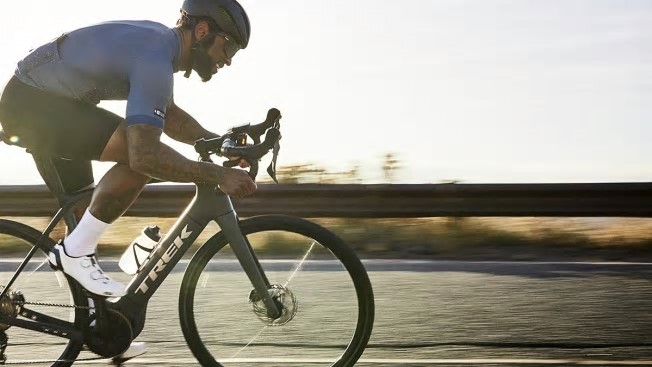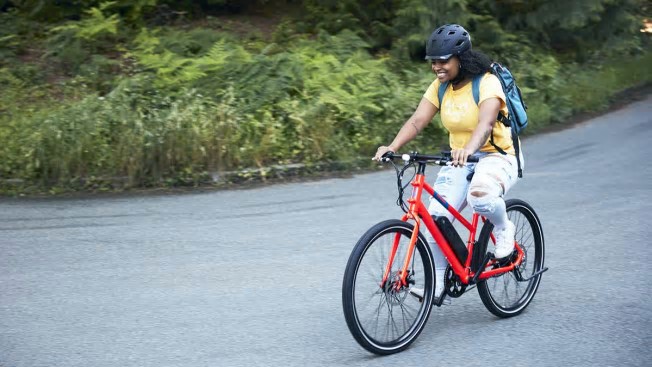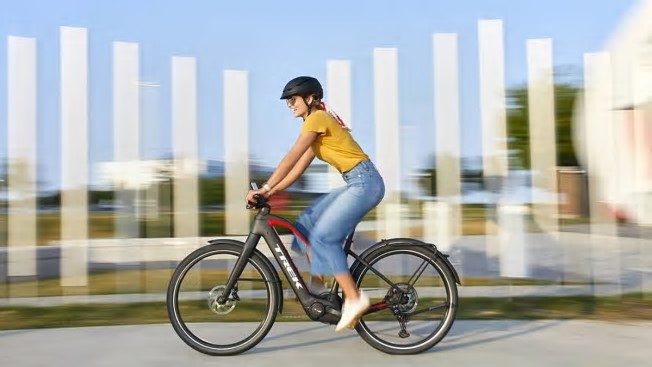Key points for selecting an electric bike

By Benjamin Preston
Electric bicycles boast significant versatility and attraction, demonstrated by their widespread use. These bikes can assist individuals who may be hesitant to cycle due to extended journeys or steep inclines by enhancing their ability to cover greater distances and climb hills more easily. Additionally, e-bikes offer pure enjoyment. However, one downside is that they tend to come with a higher price tag. If you're thinking about purchasing an e-bike We can assist you in deciding if one suits your needs.
Getting Started
The initial step when purchasing an electric bicycle, often referred to as an e-bike, involves contemplating your intended usage for it. A survey indicates that eleven percent of Americans have used an e-bike within the last year. nationally representative survey Conducted by CR of 2,035 U.S. adults in February 2024, the survey revealed that fun and leisure activities were cited as reasons why 71 percent of respondents who had used an e-bike or e-scooter within the last year decided to do so.
The number of e-bikes being owned keeps increasing. As reported by Statista, a worldwide data provider, these bicycles accounted for only 1.3% of total U.S. bike sales back in 2020; however, their share climbed to 4.9% by 2024. Experts forecast that they will constitute around 7.2% of sales this year and predict an increase to 10.5% in 2028.
There are nearly as many varieties of electric bikes as there are traditional pedal bicycles, with each type excelling at particular tasks. One major aspect influencing your choice will be where you live , due to factors like climate conditions, availability (or absence) of dedicated bike lanes, typical riding distances, and local regulations regarding electric bikes, these elements influence how effectively you can utilize an e-bike.
Over half of American states acknowledge E-bikes fall under the category of bicycles but their classification can vary based on factors such as speed and how the power is delivered—whether via the pedals or a handlebar-mounted controller. However, some states classify electric bikes similarly to other motor vehicles, mandating that operators possess a valid driver’s license for road usage, with regulations differing according to bike types. Additionally, certain regions may prohibit the operation of e-bikes altogether.
At present, there are three main categories. electric bike classifications (PDF) and a few ambiguous areas.
Class 1 This description covers pedal-assist bikes, where the electric motor assists once you apply pressure to the pedals with your feet. These bikes do not have throttles for starting; instead, they provide assistance solely while pedaling, ceasing support beyond 20 miles per hour. It’s worth noting that regular bicycles can also reach higher speeds downhill.
Class 2 Bicycles are equipped with an electric motor that operates up to 20 mph, which can be engaged when the rider is pedaling (known as pedal assist) or solely through throttle control without pedaling.
Class 3 restricts the pedal-assist function of an e-bike to 28 mph and mandates the inclusion of a speedometer.
The areas where you can use an electric bicycle may have restrictions, so it’s advisable to review local rules before riding one on trails designated for bikes only. (Electric bicycles might not be allowed.) Additionally, although your area might not mandate wearing one, it is highly suggested that you always put on a helmet.
In addition, there are more potent electric bikes designed exclusively for use in specified off-road zones. These models may appear similar to regular bicycles, yet their operation is closer to that of motorcycles. However, for the scope of this guide, our attention will primarily be on the three categories that closely mirror traditional bicycles.
What Are the Reasons for Purchasing an Electric Bicycle?
Following discussions with specialists and cyclists, we discovered that individuals primarily purchase electric bicycles for commuting, leisure activities, and transporting small loads. Certain city and town residents who started riding bikes to steer clear of public transit during the health crisis continued this practice afterward. Additionally, biking remains excellent for staying active and enjoying recreational time, particularly when aided by an electric engine.

Race-focused road bicycles emphasize swiftness, streamlined design, and minimal weight. Electric assistance aids cyclists climbing rugged inclines or pedaling against strong headwinds.
Photo: Trek
There isn't just one type of person riding an e-bike," explains Sarah Johnson, a cycling authority and promoter with experience owning a bicycle store in Omaha, Neb., which dealt in electric bicycles. "Some riders include younger individuals without cars, older folks seeking assistance to continue biking, and daily commuters aiming not to arrive at their workplace drenched in sweat.
Electric Bike Pricing
The cost of electric bicycles can vary widely, starting at under $500 all the way up to several thousand dollars. Generally speaking, many buyers might consider options around $6,000 to $7,000 as high-end. However, according to our rankings, the best-performing models usually fall within the $2,000 to $3,000 price bracket, though this may change depending on the specific kind of e-bike.
Those prices are likely to increase with the tariffs and reciprocal tariffs the Trump administration has levied on countries such as China, Vietnam, Taiwan, and Japan. They export a significant number of bicycles and parts to the U.S.

There are many designs of electric bikes available to cater to various requirements, such as transporting riders.
Photo: Rad Power Bikes
Micah Toll, who delves into the specifics of electric bicycles and other battery-driven individual transport options, Electrek stresses that it's crucial for e-bike buyers to factor in their budget.
He recommends steering clear of lower-end electric bikes with inexpensive parts, which may compromise the overall performance. Additionally, he suggests that beginners should perhaps skip the priciest models until they determine their comfort level with e-biking. Despite numerous choices available across various budgets due to the increasing popularity of these vehicles, he notes that around $1,500 often represents a good balance between cost and value. While you could come across less pricey versions made by lesser-known brands appearing on platforms such as Amazon, high-quality e-bikes typically fall within the $1,500 to $2,000 bracket. This suggested amount does not include additional costs for tariffs or duties.
There are now more participants in the industry than at any time before, and the range of choices has significantly broadened across both budget-friendly and premium segments," explains Toll. "The manufacturers are producing bicycles with decent quality without equipping them with top-tier parts. This offers an ideal compromise for those unwilling to splurge yet desire their bicycle not to disintegrate within one or two years.
Commuter Electric Bikes
Commuter bicycles offer numerous designs yet share the purpose of serving as functional transport. To many buyers, electric bikes provide a significantly more economical choice compared to costly vehicles reliant on fossil fuels—or at minimum, a means to decrease the vehicle count in their garage. Numerous individuals appreciate being able to travel to work via an electric bicycle without arriving overly perspired and also have less chance of being delayed in slow-moving vehicular congestion.

Citation bicycles offer convenient maintenance for everyday travel and minimize the likelihood of arriving at your job overly perspired.
Photo: Rad Power Bikes
Steve Volkers, residing in the suburbs of Maryland, finds himself getting to work slightly quicker with an electric bike due to avoiding congested traffic in the Washington, D.C., region as he navigates across hilly terrain for several miles during his commute.
Glen Mayenschein, who commutes several miles from his house in northern New Jersey, has ridden a bicycle to work exclusively for two decades. At the age of 62, he chose to purchase an electric bike.
“I have a bad knee, so I figured I’d make it easier on myself and get an electric bike,” he says, noting that he rides a hilly route to and from work. “I like riding a bike, and I still ride regular ones from time to time, but now I mostly ride the electric one.”
Commuter bicycles come in different varieties. Urban residents often notice slim tires paired with straight handlebars. However, those who travel routes featuring un paved sections might see more robust versions equipped with wide tires and sturdier frames.
Specialists indicate that fat-tire bicycles—which tend to be challenging to start using only pedaling—have grown in popularity as their electric variants have become more readily accessible. Additionally, folding electric bikes those that can be easily stored in a compact space or on public transportation like trains and buses.
Recreational Electric Bikes
Based on data from Circana, an analytics and tech firm, the majority of the surge in bicycle sales during the pandemic was for high-end bikes such as road and mountain varieties. These types of cycling were already well-liked pastimes, but the introduction of electric assistance further boosted their attractiveness.
Several investigations indicate that electric bicycles offer exercise advantages although they constitute a lower intensity workout compared to traditional bicycles. For instance, a 2021 study published in Translational Journal found that when compared to a conventional bicycle, using an electric bike for a simulated 3-mile journey led to reduced metabolic, cardiovascular, and perceived exertion levels but still maintained the intensity needed for healthy physical activity as suggested by the World Health Organization and the American College of Sports Medicine guidelines. (ACSM advises getting at least 150 minutes weekly of moderately intense cardio workouts.)

Cruiser bicycles prioritize comfort in their design.
Photo: Trek Bicycle
Similar to traditional bicycles, various kinds of e-bikes exist, designed for specific uses. These can be tailored for navigating rugged terrains like mountains and forests, cruising along extensive routes on paved roads, or enjoying relaxed rides close to one’s neighborhood. Die-hard cyclists might criticize electric bikes due to the reduced effort required in pedaling; however, many new enthusiasts express their fondness for these vehicles.
An additional power source from a battery and an electric motor has similarly enabled individuals who wouldn’t typically be capable of riding bikes to take part. According to Sarah Johnson, an advocacy figure from Omaha, she was considering stopping cycling due to health issues that hindered her ability to operate a standard bike.
I used to dislike electric bikes, but once I understood that it was either use an e-bike or not ride at all, I came to appreciate their benefits," she explains. "I'm feeling much better now, but I doubt I'll ever part ways with my e-bike.
Performance Road Bikes The key features of a road bike typically include a light frame, smooth tires, and curved handlebars designed for an aerodynamic posture. You often spot groups of riders wearing vivid tops vigorously cycling down trails or beside roads aboard these nimble speedsters.
Similar to traditional bicycle models driven by pedals alone, electric road bikes come equipped with slender, lightweight parts and necessitate a streamlined posture for optimal performance—both designed to boost effectiveness during extended rides. With the support provided by an electric engine, riders can travel greater distances, conquer inclines more easily, or cycle against strong winds without experiencing as much tiredness compared to what they would typically feel when using standard bicycles.
Although they're quick and fairly lightweight, performance bikes may not suit everybody. Typically, the intense, bent-down seating posture can feel uneasy for certain cyclists.
Mountain Bikes Equipped with sturdier frames, larger wheels, and often featuring extended travel suspensions, mountain bikes are designed to tackle rugged paths, sizable boulders, tree trunks, and various challenging terrains and barriers. Browsing through online clips of mountain biking competitions shows that these cycles frequently endure even greater challenges from their riders—such as soaring over big jumps and navigating extremely uneven landscapes.
The most enjoyable aspect of mountain biking is undoubtedly the swift, downward journey. However, reaching that point typically requires a strenuous effort as you navigate your way up steep inclines over unstable ground. For those eager to enjoy the excitement of racing down hills without necessarily possessing the stamina needed for the arduous ascent, equipping a mountain bike with an electric motor proves quite sensible.
Due to the added mass and higher rolling resistance from their robust wheels and tires, cycling on bicycles equipped with larger components can become quite tiring. However, incorporating electrical assistance greatly enhances the appeal of such bikes since you can cover greater distances in a single outing. Nevertheless, keep in mind that e-mountain bikes may not be allowed on certain trails, so verify the rules set forth by your state and locality. Additionally, our testing team discovered that purchasing an e-MTB with braking systems capable of managing the additional load from both the battery and motor is crucial for safety and performance.
Hybrids and Cruisers Hybrid bikes combine the speed and agility of road bicycles with the comfortable, upright posture favored by mountain bikers and city riders. These versatile cycles serve as an excellent choice for those who want to enjoy the advantages of both types of bikes in one package.
Cruisers offer a relaxed, comfortable, upright seating position and often a softer ride because of bigger tires and cushier seats. Look for swooping handlebars that keep your arms at a relaxed distance from your body. The addition of an electric motor to either of these configurations makes it possible to use a thicker frame and wider tires to soak up bumps in the road. Volkers, the Maryland commuter, bought this type of e-bike because he can ride it on light off-road trails and paved roads with ease.
Cargo Electric Bikes
Cargo bikes are designed to transport goods and additional riders. Featuring sturdy frames, wider tires, and durable parts, these vehicles stand out as the heavy-duty giants among bicycles. These pedal-driven cargo bikes have existed for some time now and come equipped with various setups such as back-attached seating, freight platforms, or forward-facing storage compartments bolstered by single or dual wheels. Cycle rickshaws fall under this category too. The prevalent two-wheel versions are widely used for city-based deliveries and carrying kids.
Integrating electrical assistance into a structure built for transporting substantial weights provides a clear benefit. Electric drive systems can revolutionize the way people utilize bicycles as substitutes for cars when performing tasks such as carrying bulky shopping items, parcels, or even ferrying multiple passengers. While e-bikes aren’t exclusively made for heavy-duty hauling, they have become quite prevalent among individuals delivering meals due to their enhanced capabilities.
Folding Electric Bikes
Consider a folding bike as a more convenient alternative to a standard commuter bike. These bikes typically feature smaller wheels along with extended handlebars and seats, coupled with hinges in their frame design and various components enabling them to collapse into a tighter form factor. Such bicycles could appeal to individuals needing portability due to constraints like fitting within an automobile trunk or transporting via public transit, or those dealing with restricted living spaces where they store their ride. The marketplace includes multiple options equipped with electrical assistance; however, it should be noted that these often come with stronger engines which can make the overall unit bulkier and harder to manipulate when folding, carrying, or storing. Nonetheless, Consumer Reports evaluated one particular variant that provided assistive power yet maintained lightness and ease of reduction for seamless transportation or conservation purposes. (Referencing CR’s compilation of recommended choices.) best folding bikes .)
Electric Bike Safety Considerations
Electric bikes can reach velocities comparable to those of traditional bicycles and come with equivalent safety hazards. However, models capable of exceeding 20 miles per hour introduce an additional layer of danger into the mix.
Faster speeds provide you with reduced time for deceleration or halting. This applies whether you're cycling on a bicycle or motorcycling; accidents at minimal velocities can still result in severe injury or death, particularly when automobiles and lorries are part of the equation. Research published in 2019 within the journal Injury Prevention revealed from analyzing hospital admission reports that e-bike operators had a higher chance of experiencing internal harm compared to individuals using standard bikes.
The simplest and clearest method to prevent a severe head injury is by wearing a bicycle helmet. According to a 2007 review of bicycle helmet research featured in the journal Injury Prevention, this measure has been highlighted for its effectiveness. wearing a helmet might decrease the likelihood of severe head injuries by 63 to 88 percent. Additionally, a 2021 research conducted by the Centers for Disease Control and Prevention discovered that from 2009 to 2018, nearly 600,000 emergency room visits were due to bicycle-related traumatic brain injuries (TBIs). Wearing vibrant attire and following traffic regulations may also provide assistance.
An essential aspect of bicycle safety involves having access to designated and well-protected bike paths. When sharing the roadway with vehicles becomes necessary, consider the current traffic speed and volume. Drivers might not notice cyclists due to distractions or excessive speeding.
Aftermarket accessories can be installed on any bike, offering functionalities akin to those found in the original setup. advanced driving aid systems seen in automobiles and commercial vehicles . They include blind spot warning and crash detection.
So far, little scholarly research has explored the potential injuries to kids from the latest electric bicycles. However, it's advisable to be extremely careful when dealing with novice or unskilled riders. Anyone who remembers tumbling off a bike during their youth knows that accidents at slow speeds, such as falls or tips, can still lead to harm.
Since most electric bikes utilize lithium-ion batteries, this leads to fire risk It’s crucial to utilize the appropriate charger and charging cable provided by the original manufacturer of your bicycle. Although lithium-ion battery fires are uncommon, they can lead to substantial harm when they do occur. Typically, such incidents happen due to incorrect charging or storing practices.
In case you need to replace the battery for any reason, make sure to use only a UL-certified battery recommended by the bicycle’s manufacturer. It’s best to charge the e-bike in an area where you can keep an eye on the vehicle, and avoid charging e-bikes in bedrooms or locations where they might obstruct access to rooms or buildings.
Consumer Reports is an independent, non-profit entity working alongside consumers to build a more equitable, secure, and healthy environment. They do not promote goods or services and refrain from accepting advertisements. Copyright © 2025, Consumer Reports, Inc.
